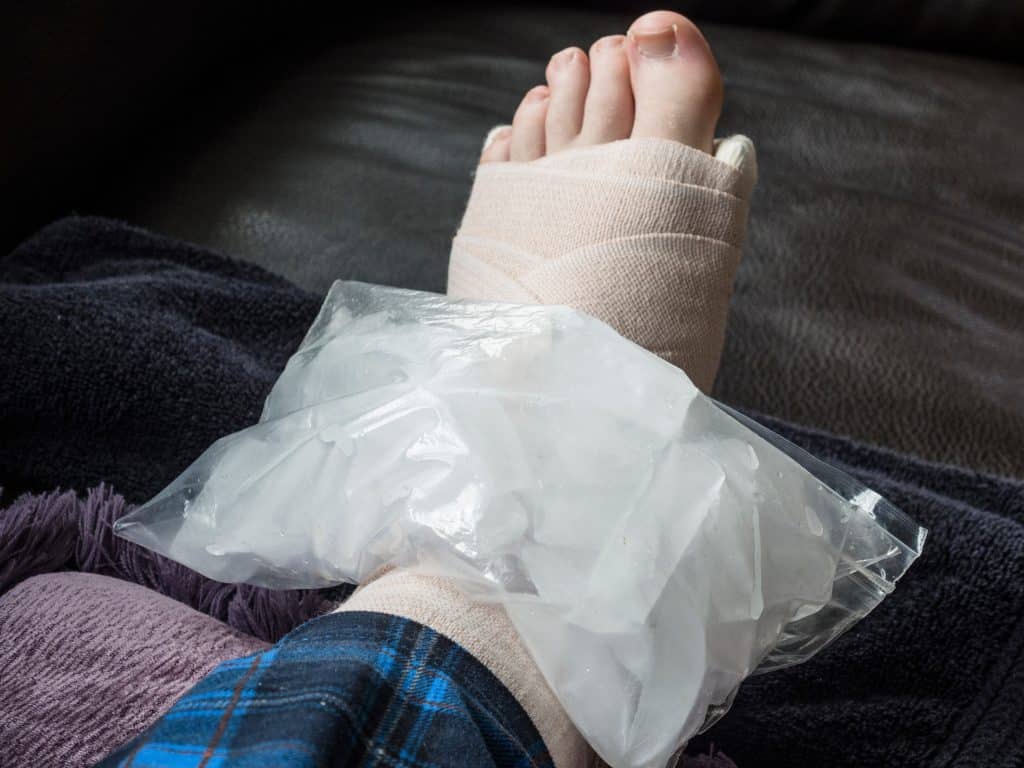Sprain vs Fracture: Is Your Bone Broken?
If you’ve rolled your ankle or caught yourself with an outstretched arm, you may have done some Googling for symptoms of a sprain vs. fracture. But since both can cause acute pain, swelling, and bruising, it can be hard to tell whether you simply need to let it rest or if you’ll end up getting it cast.
Knowing the symptoms of sprains vs. fractures can help you decide when and where to seek treatment. Since both of these injuries can be quite severe, getting a proper diagnosis is important to ensure proper healing.
Sprain vs Fracture
Sprains and fractures can both be serious joint injuries affecting areas like your ankle, foot, or wrist — but they aren’t the same thing. However, they can have many of the same symptoms, so it’s important to know what to look for so you know when to seek urgent medical attention.

A sprain occurs when you stretch or tear ligaments (fibers that connect a bone to another bone) in a joint. A fracture is a crack or break in a bone. Both sprains and fractures can vary in severity, so it’s a good idea to see an orthopedic or sports medicine specialist for a proper diagnosis.
As with sprains, fractures vary in severity. Hairline fractures are small cracks in bones, partial fractures are larger cracks, and complete fractures are when a bone breaks into two or more pieces. If a bone is broken, it will also be classified as either simple (a closed fracture) or compound (an open fracture). In a compound fracture, the bone breaks through the skin, whereas in simple fractures, it does not.
Symptoms of a Sprain vs Fracture
There are a few things you can pay attention to at the time of injury and after that can clue you in as to whether you have a sprain or fracture, such as:
- Sound: Generally speaking, spraining a ligament does not produce a sound unless the sprain is severe, in which case you may hear a pop. You might hear a cracking or crunching sound if you break a bone.
- Source: If you touch the area gently and your pain and tenderness are in the soft tissue around the joint, it may be a sprain. If it hurts when you put light pressure on the bone where there is no soft tissue, it could be a break.
- Shape: Both types of injuries cause symptoms like swelling and bruising, but if the joint looks odd or quite different from normal, you probably have a fracture.
- Sensations: Sprains and fractures are both painful injuries. You generally won’t be able to use or put weight on a broken bone, whereas those things may just be painful and limited with a sprain. You may also notice tingling or numbness with a fracture.

Because sprains vs. fractures have many similar symptoms, the best way to determine which injury you have and how to treat it best is to get an X-ray. With X-ray imaging, your orthopedic specialist can see if your bone has cracks or breaks.
If you can see the bone through your skin, go to the emergency room for immediate attention. Compound fractures are serious injuries that require prompt care to avoid serious or long-term issues. Similarly, if your joint looks misshapen, visit the ER or urgent care, as they may need to reset (reduce) your bone as part of treatment. If the possible break is in a large bone, such as your femur or humerus, or if it’s in your head or back, it’s also best to seek emergency care.
Common Joints and Bones for Sprains vs Fractures
Virtually any joint or bone in the body can be sprained or broken. The ankle and wrist are some of the most common areas for sprains and breaks, though many other joints and bones can also be injured in these ways.
See these posts for more information on the following fractures and sprains:
- Clavicle fractures
- Humerus fractures
- Radial fractures
- Pelvis fractures
- Femur fractures
- Tibia fractures
- Fibula fractures
- Foot fractures
- Ankle fractures
- Foot sprains
- Ankle sprains
- High and low ankle sprains
Sprained Ankle vs Broken Ankle
The most commonly sprained joint is the ankle, and ankle sprain symptoms are similar to those of ankle breaks. To determine whether you have a sprain vs strain, your specialist will evaluate your soft tissue injury. A strain is when you stretch or tear a tendon or muscle in your ankle. Hurting your ankle is common, so looking into ways to prevent ankle injuries can be helpful.
Wrist Sprain vs Fracture
If you fall and catch yourself using an outstretched hand or hands, you may cause a wrist injury. If you damage the ligaments in your wrist, you have a sprain. You have a fracture if you break one or more bones in the wrist. As with other joints, broken wrist symptoms are similar to those of sprained wrists.
Treatment for Sprains vs Fractures
Like sprain and fracture symptoms, sprain and fracture treatments have some areas of overlap and some differences.
How to Treat a Sprain
Generally speaking, sprains will feel better within a few days or weeks, though more severe sprains can take a little longer. Most heal on their own, though you may also want or need help from a physical therapist as you build strength and range of motion.

To help the process along and lessen your pain, you can take anti-inflammatory medications and use the RICE protocol:
- Rest: Avoid or decrease how often you move the injured joint, especially during initial healing when it’s still swollen and tender.
- Ice: Apply a wrapped ice pack in 20- to 30-minute increments to reduce swelling and pain.
- Compression: Use an elastic bandage, compression sleeve, or brace to apply light pressure to the joint.
- Elevation: Keep the injured area elevated above your heart to help with pain and swelling.
How to Treat a Fracture
Fractures take longer to heal than sprains, typically several weeks to months. There are many different types of fractures, all of which need treatment to heal properly.
To treat your fracture, you may need to do the following:
- Have your bone reset to realign it if needed
- Get a cast on the bone to keep it still and stable
- Avoid putting weight or pressure on the bone
- Ice the area to help with pain and swelling
- Take over-the-counter or prescribed pain relievers as needed
- Get surgery by an orthopedic surgeon to repair the damaged bone
If you have a joint injury and want to be sure you get the best treatment for proper healing, contact us or comment below.
Leave a Reply